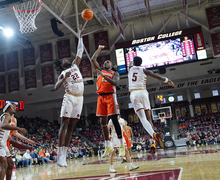‘Soundtracks for the Present Future’ brings spiritual showcase to the Everson
Jaden Chen | Assistant Photo Editor
The exhibition, which consists of around 60 guitars, basses and mandolins hanging from the ceiling, opened on Jan. 29 and will remain open until April 10.
Charley Friedman’s exhibition “Soundtracks for the Present Future” at the Everson Museum of Art is unlike any of the exhibitions surrounding it. In a gallery adjacent to it, Dawn Willams Boyd’s exhibition “Woe” contains a standard display of her powerful cloth paintings. Meanwhile, Friedman’s unconventional “Soundtracks for the Present Future” consists of about 60 guitars, basses and mandolins, all hanging from the ceiling.
Friedman is a sculptor and artist from Nebraska who has had shows across the country. He is known for the combination of humor and science in his work, said Garth Johnson, the curator of ceramics at the Everson. As seen in “Soundtracks for the Present Future,” Friedman is always looking to innovate and come up with new ways to create and render his ideas.
Each instrument used in “Soundtracks for the Present Future” was modified by Friedman so that they all have one string that is tuned to a specific note, controlled by a computer set up in the middle of the room. The effect this creates is very ethereal, as after every pluck, there is a long resonance due to the acoustics inside the Everson. Each instrument is hung from the ceiling by fishing wire to about body height, which was intentional, Johnson said.
“There’s a reason why the guitars are at your heart. Your body has this relationship in this space too,” Johnson said. “The reaction you get from when a string goes off near you, you really feel it’s something special.”
The computer the guitars are connected to plays songs that are programmed into the computer in a random order, acting as a kind of conductor, Johnson said. Much of the music played was composed specifically for the exhibit, with 22 compositions alternating through the shuffle.
Since the exhibit was first opened at the Everson on Jan. 29, David Fulmer, a composer who works in residence at the Everson, wrote a few compositions which have been added to the exhibit, alongside the original compositions provided by Friedman. Fulmer, who is also a professional violinist, said he was immediately inspired when he first experienced the soundtracks.
“So many ideas were conjured up when I first saw the composition,” Fulmer said in an interview with the Everson. “One of the most remarkable features of the exhibition is the diversity of the sound palette presented here.”
This diversity Fulmer referred to was born out of how the exhibit came together. Friedman utilized mainly previously owned instruments from a variety of places into this exhibition to ensure a wide palette of sound.
Johnson said he sees the application of instruments of varying age, quality and use as part of the greater metaphor of the exhibition itself. He tries to use the exhibition to explain to tour and school groups the importance of diversity in a community.
“I love to ask students, ‘Are these flawless, musician-ly guitars?’ And someone will say, ‘They’re crappy’ or ‘They’re well loved,’” Johnson said. “Each guitar has very different tones … but when everything comes together to make music, it’s a really great metaphor about society.”
Another aspect of the exhibition of particular interest to Johnson was the intersectionality it created within itself. It combines art, music and science into a stunning soundscape that immerses people into the music being played.
While the museum asks that nobody touch the instruments, visitors are encouraged to walk around and through the exhibition. The guitars are organized in no particular order, so regardless of what song is playing, a guitar nearby may be plucked.
Visitors choose where to enter and exit the exhibit, so each experience is unique. They can also move around within the exhibit, thus Friedman allows visitors to fully immerse themselves. This interactive element compels visitors to create a connection to his work, Friedman said. He is exploring the connection an individual can experience through music, and how that experience can connect them to the community.
“There is no beginning, middle or end, so it depends on you, the individual, to go in and be in sync with it in your own particular way,” Friedman said in an interview with the Everson. “Music, in particular, is one of those things that when it goes into your body it affects you on an emotional level. I wanted to construct a piece that somehow navigates between the individual and the community and how those two things can weave a narrative back and forth.”
One result that came out of the exhibition is the reaction from the musical community of Syracuse. Improv groups from around the area have come into the museum to interact with the exhibition.
David Fulmer is holding a performance with the exhibition on March 31, using the instruments from the exhibition to accompany him as he plays a violin with this automated orchestra. Following this an improv group will perform on April 7 with the “Soundtracks,” the last event before the exhibit closes on April 10. These events have exceeded Johnson’s expectations and has led him to feel a large sense of pride at bringing this work in, he said.
“I find this piece particularly spiritually moving,” Johnson said. “This has really been, out of my entire career, the exhibition I find the most moving. The way the public have responded, the way the music community has responded has been incredible.”
Published on March 9, 2022 at 12:14 am





